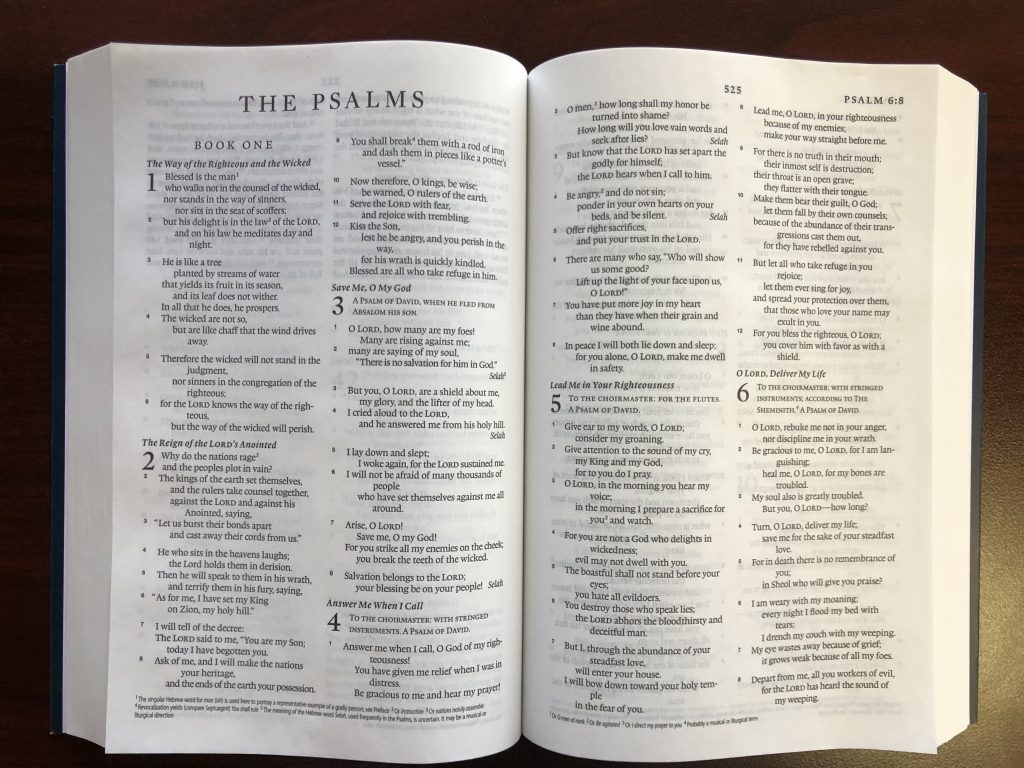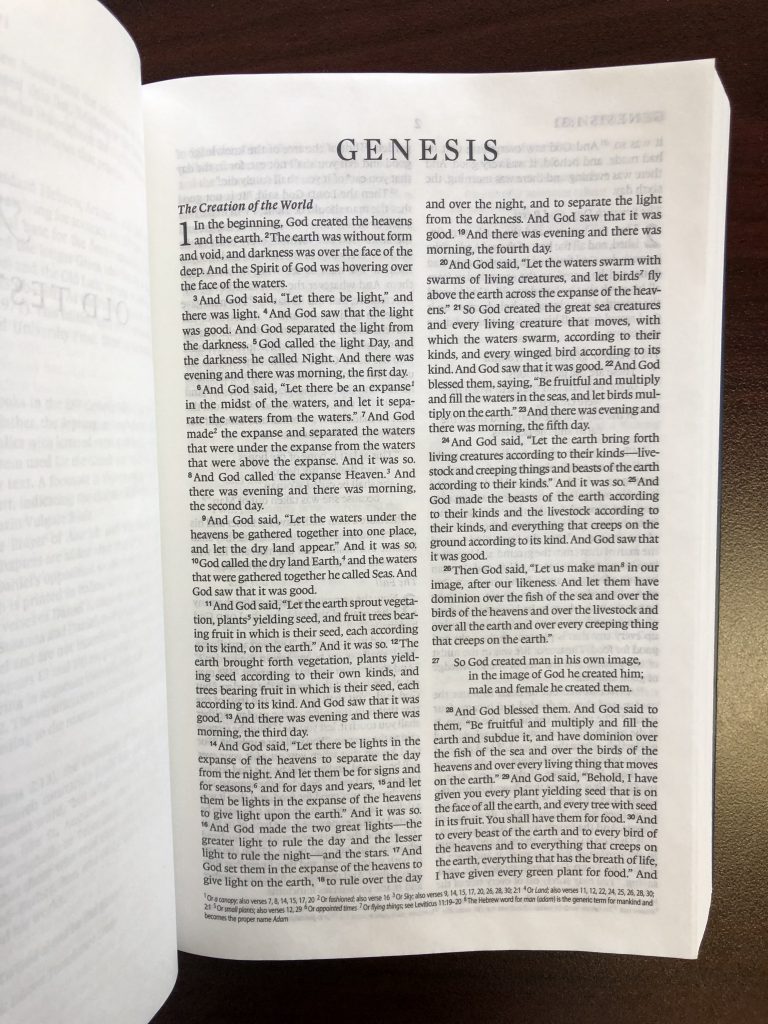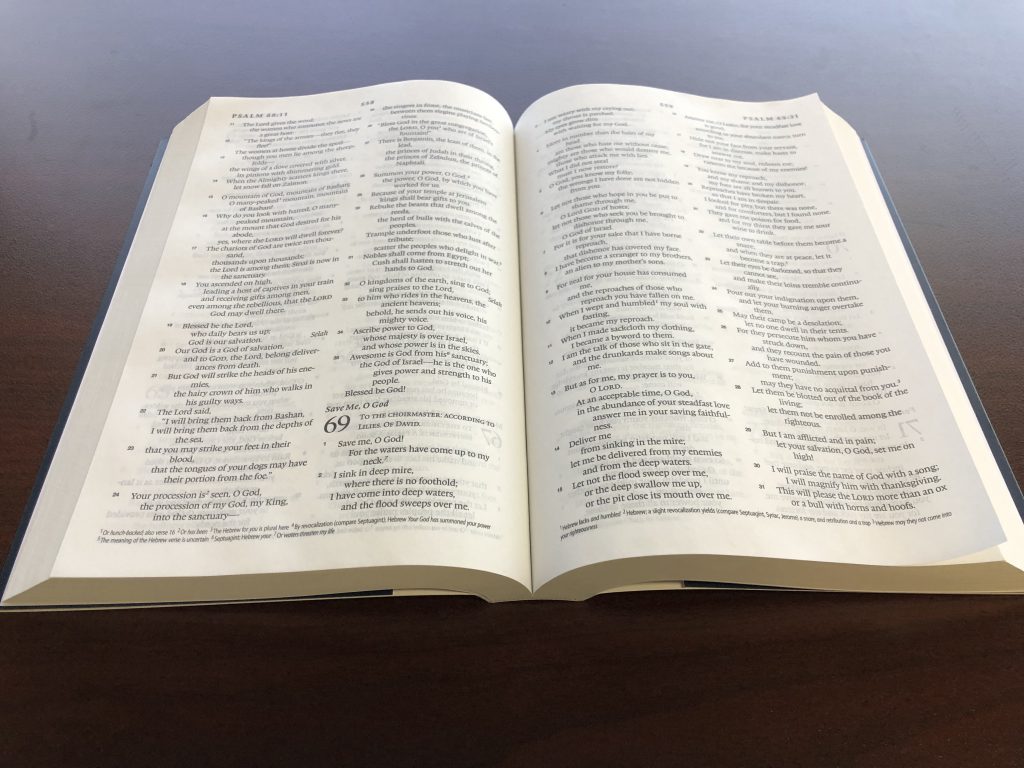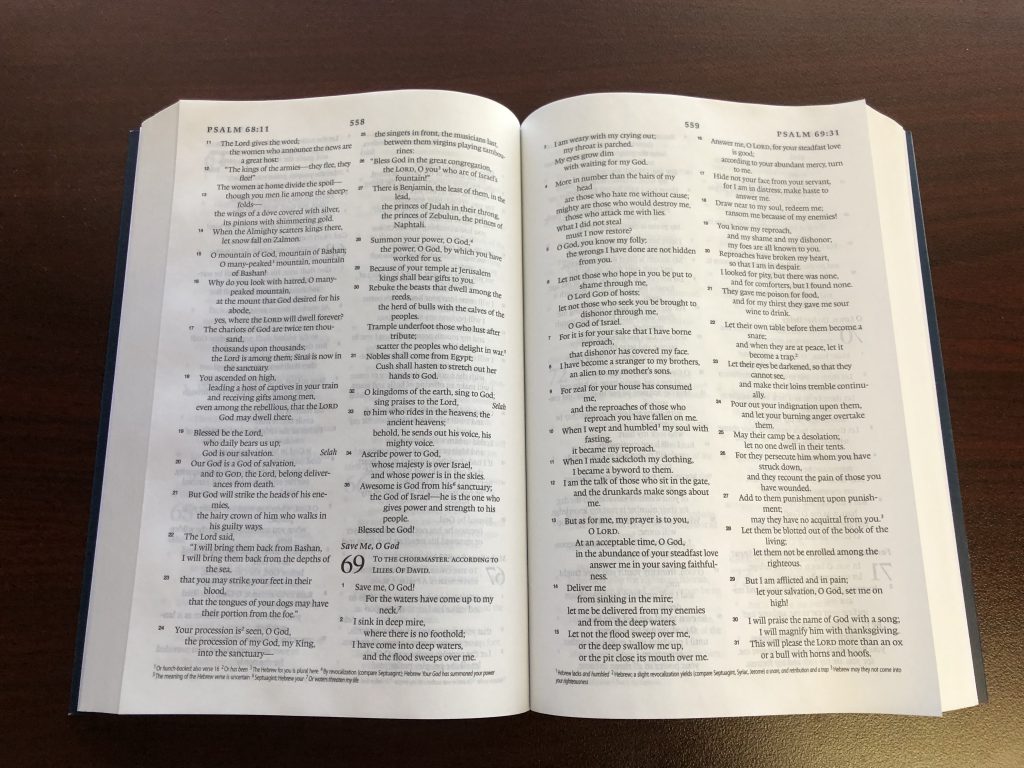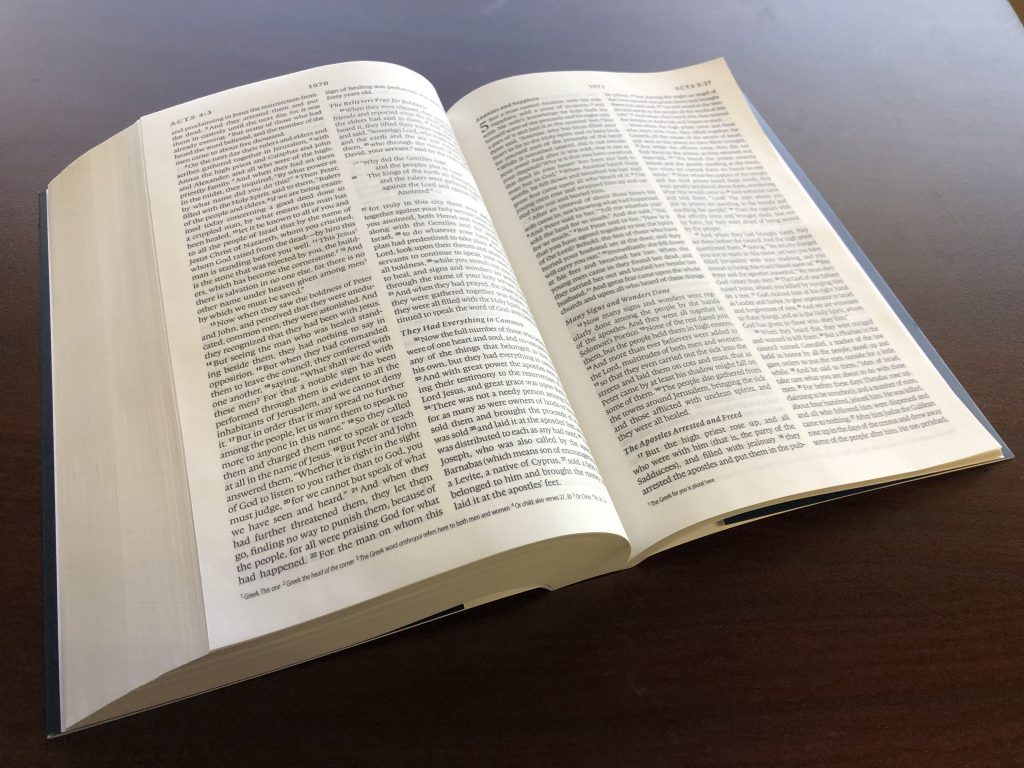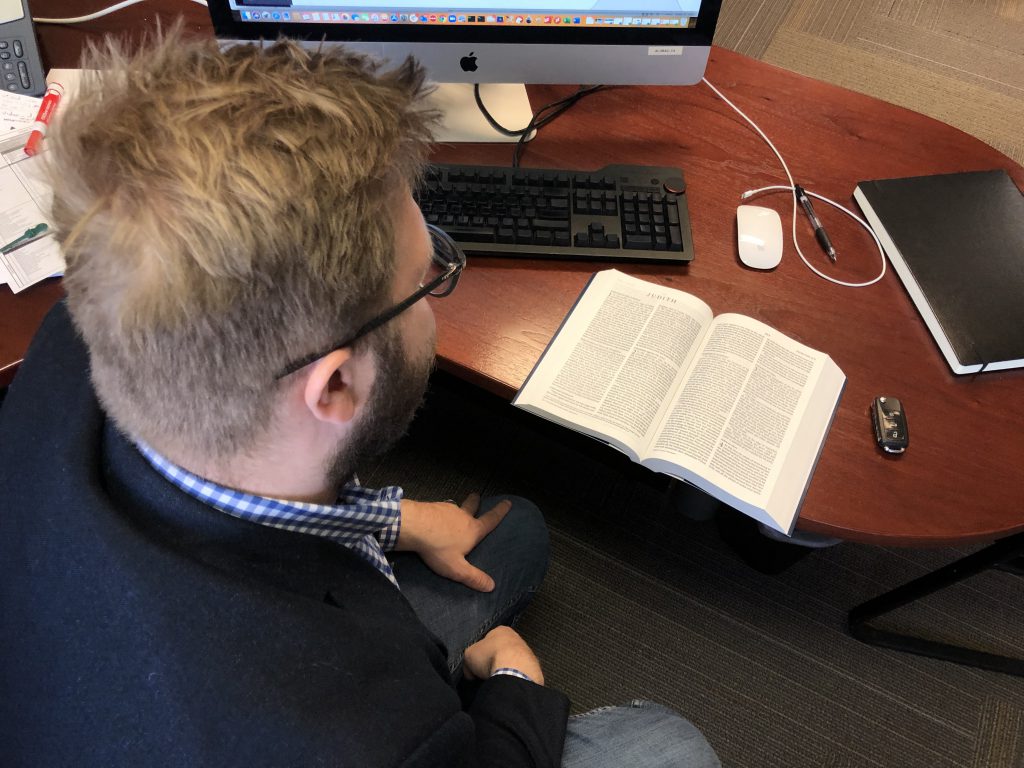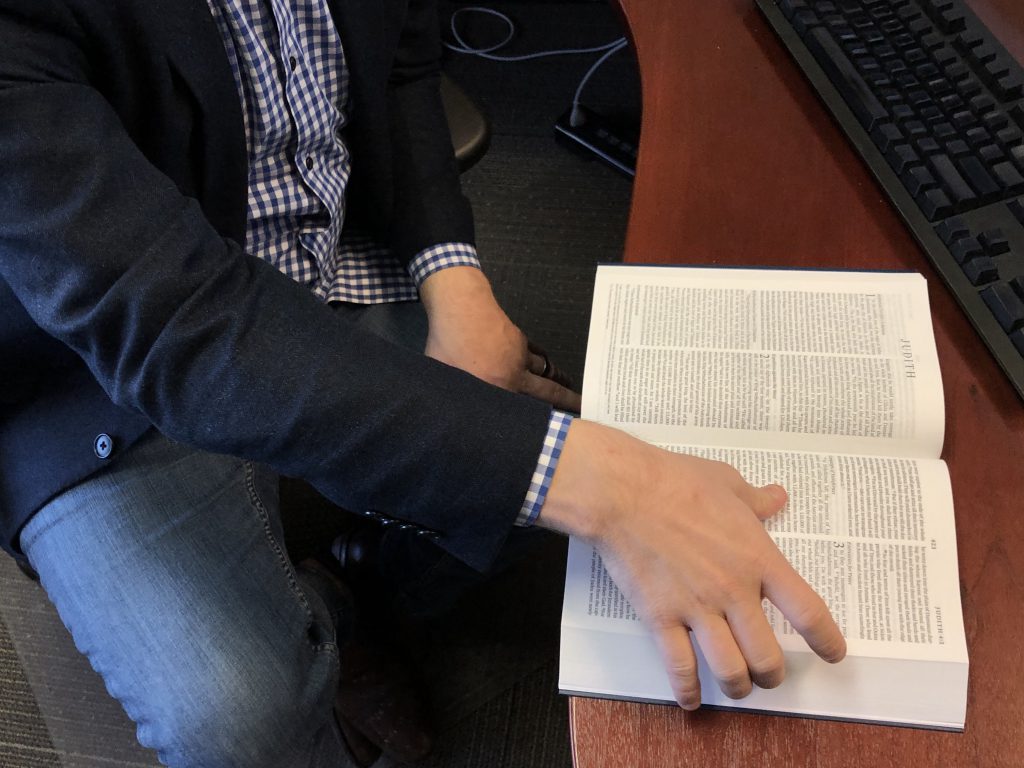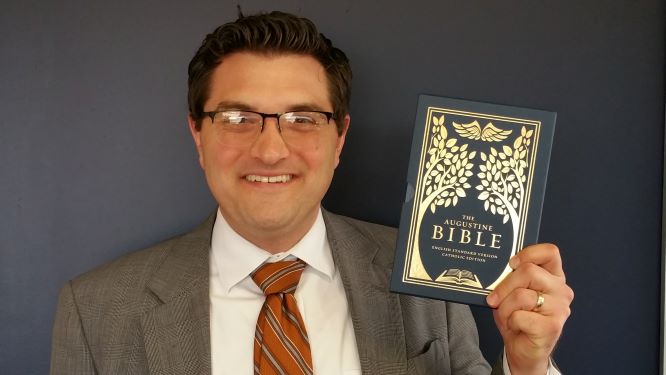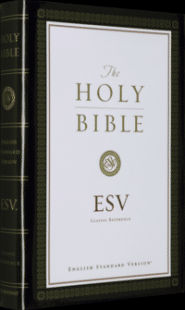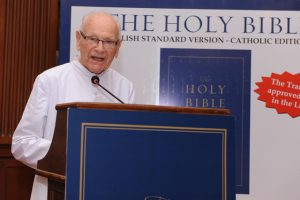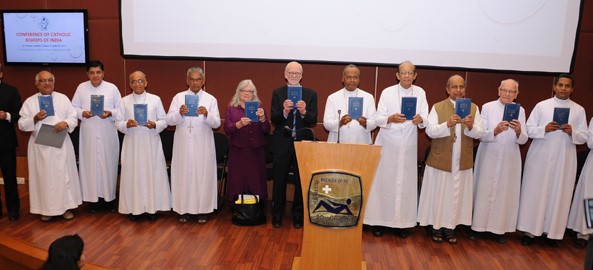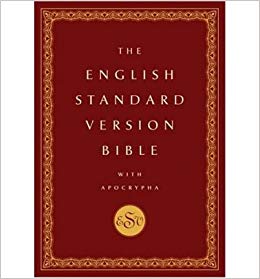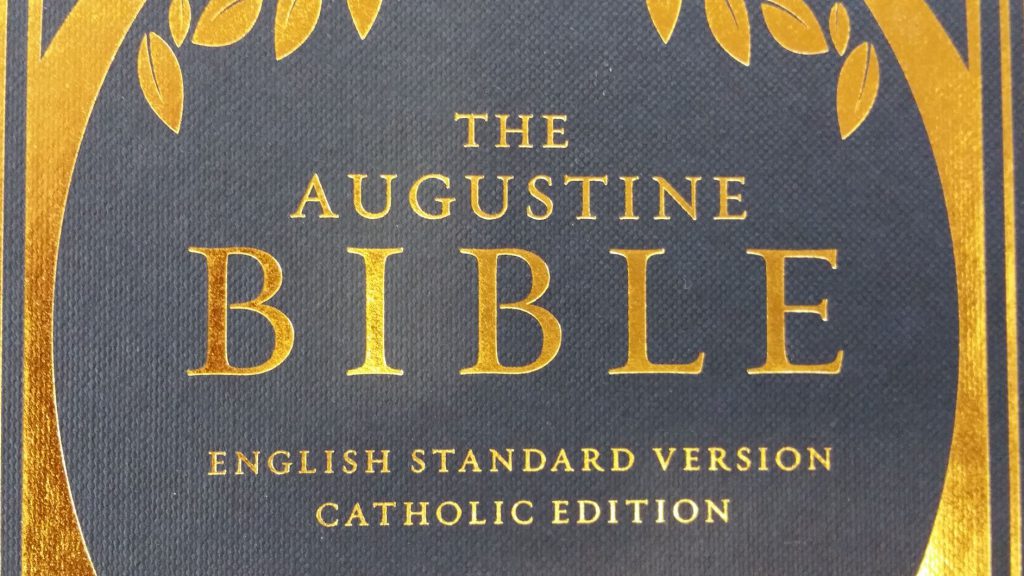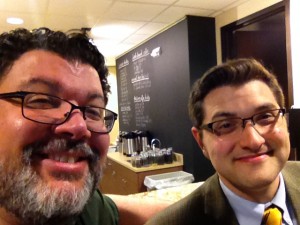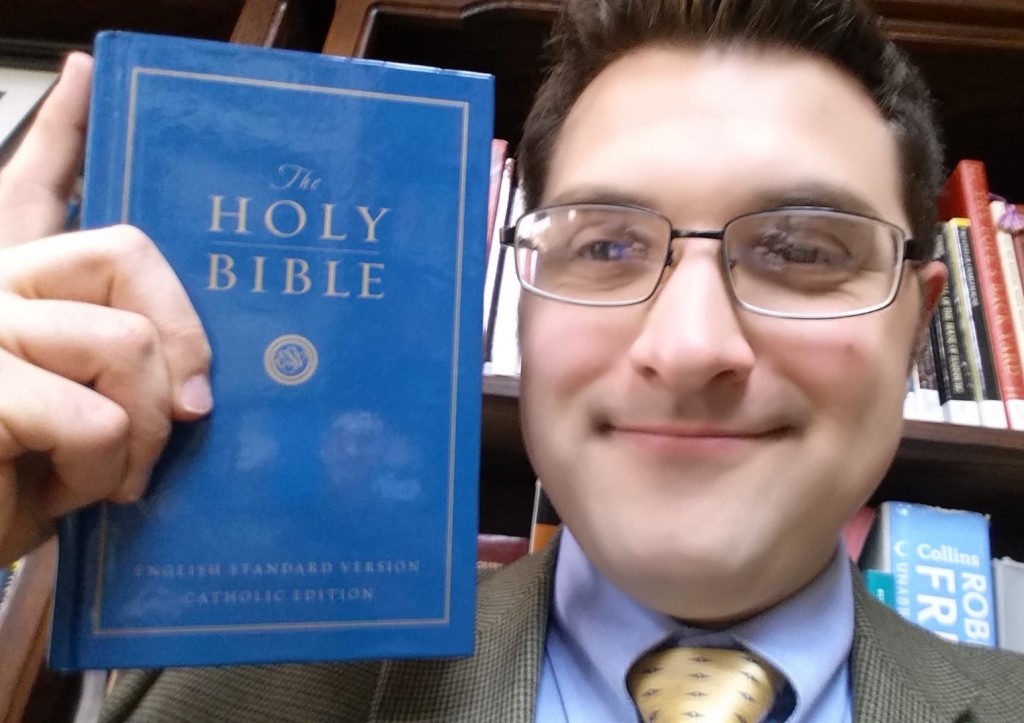
I got one! Yes, I think I might be the only Catholic in the United States to hold in my hands the new English Standard Version Catholic Edition Bible (ESVCE). Through my super-secret trading channels, I was able to secure one and now will offer a review and a backstory, just for you, my faithful reader. The Bible is printed on thin, high quality Bible paper in a very readable font. It feels just right in the hand—a bit smaller in form factor than your typical Bible with smallish print throughout. It contains a short Foreward, a Preface, a few grayscale maps and a chart of weights and measures. Thankfully, these materials explain the exact texts on which the translation was based.
Update 12/13/2019: ESV Catholic Edition Now Available in the United States!
A Breath of Fresh Air!
Finally, we Catholics get a new translation in clear English with serious attention to exact fidelity to the original text: the English Standard Version Catholic Edition, just released by the bishops of India. The same debate has been raging since the 1960’s in the English speaking world—on the relative merits of the New American Bible (1970), Revised Standard Version Catholic Edition (1966) and the Jerusalem Bible (1966). While we have received welcome updates on these translates like the NAB revised New Testament (1984), the New Jerusalem Bible (1985), the NRSV Catholic Edition (1991), RSV-Second Catholic Edition (2006), and the updated Old Testament in the NAB Revised Edition (2011—notice the 27-year delay between revised NT and OT), this ESVCE is a truly new Bible translation for us. Though it takes its cues from the 1971 RSV, the ESV stands on its own with its own translation philosophy and its strong commitment to clear and meaningful English that stays truly faithful to the original languages. (I’m not even including the simplified or quasi-paraphrase translations like the Good News Bible.)
Students, Bishops and the old Douay-Rheims
Catholic students of the Bible (who both read and write this blog!) have been arguing for years round and round about whether the RSV or NAB is better. Not only that but bishops’ conferences in the English-speaking world have been going round and round about which translation to use at Mass. The old Douay-Rheims translation (and its “Confraternity edition” followups) was discarded as antiquated after the Second Vatican Council. Besides, the old D-R was based on the Vulgate and did not take the Greek and Hebrew witnesses seriously. But after discarding the Douay, bishops were left with a problem on their hands. Fortunately, for American Catholics, the U.S. bishops had commissioned the Catholic Biblical Association of America to produce a new translation back in 1943, after the publication of Pope Pius XII’s encyclical, Divino Afflante Spiritu.
A Footnote from 1943
It’s an odd footnote to biblical history that the CBA had originally been commissioned to produce a new translation from the Latin Vulgate which was scrapped after Pope Pius XII encouraged recourse to the original languages (see paragraphs 14-16). The encyclical, which was drafted by biblical scholar Augustin Bea (later a cardinal), insisted that “we [ought] to explain the original text which, having been written by the inspired author himself, has more authority and greater weight than any even the very best translation, whether ancient or modern” (§16). This one line, along with the developing knowledge of biblical languages promoted by the Pontifical Biblical Institute, was instrumental in getting Catholics off the couch and into Greek and Hebrew courses. It sidelined Vulgate-only translations and insisted on fidelity to the original languages (Hebrew, Aramaic, Greek) in new translations.
Back to the Bishops
The bishops, since 1943 (and with renewed zeal after the Council), have been casting about for good Bible translations. Other language communities have perhaps done a better job cooperating, but the English-speaking world has been characterized by fierce competition. In particular, the United States Conference of Catholic Bishops actually owns the copyright to the New American Bible, so it is in their financial best interest to promote, and yes, to require, the use of the NAB/NABRE in liturgical settings. Though the USCCB does approve of other translations for non-liturgical use. The other English-speaking bishops (UK, Canada, Australia, New Zealand, India) have been none too thrilled about paying royalties to their brother prelates, so have normally opted for the Jerusalem Bible, but have also approved the New Jerusalem Bible, and the RSV. The Canadian bishops have adopted the NRSV as of 2008. The Antilles adopted the RSV-2CE for its lectionary. My sense is that many bishops’ conferences are none too thrilled with these options. The complaints, though often whispered, are easy to summarize:
The ESVCE gives the bishops conferences a new option and indeed, several English-speaking bishops conferences have reached out to the Indian bishops to explore the possibility of using the new ESVCE lectionary in their countries.
ICEL, Liturgiam Authenticam, Vox Clara
To understand the backroom politicking at work, we must at least nod at some big decisions at the Vatican. After Vatican II, the English-speaking bishops set up the International Commission on English in the Liturgy (ICEL) to translate liturgical texts—including the Roman Missal, the Liturgy of the Hours, the Roman Martyrology and so forth. However, Bible translations, while often handled separately, had to be approved in the form of Lectionaries. In 2001, the Vatican issued a document entitled Liturgiam Authenticam which laid down rules for liturgical translations, which included Lectionaries. The Congregation for Divine Worship issued a new edition of the Latin missal in 2002,which served as the basis for the translation of the liturgy released in 2011. In order to implement Liturgiam Authenticam in the English-speaking world, the Vox Clara Commission was set up to oversee the work of ICEL (an angry history of it HERE). The Vox Clara Commission included some well known conservative churchmen (George, Pell, Olmstead). Notably, it also included Cardinal Oswald Gracias, who gave the imprimatur to the ESV-Catholic Edition and wrote the foreward. Recent news has seen Pope Francis moving to roll back a bit of the centralization of translation.
Back to Bible Students
Now, we Bible Students care little for the squabbles of high prelates: How faithful is the actual translation? Here’s where we get into the weeds to compare actual texts. I’m going to use the NABRE, the RSV-CE and the ESVCE to show you what we have on our hands. I’ll just present a bunch of examples without comment in no particular order. You can judge for yourself:
| |
NABRE |
RSV-CE/2CE |
ESVCE |
| Prov 18:24 |
There are friends who bring ruin, but there are true friends more loyal than a brother. |
There are friends who pretend to be friends, but there is a friend who sticks closer than a brother. |
A man of many companions may come to ruin, but there is a friend who sticks closer than a brother. |
| Luke 1:28 |
And coming to her, he said, “Hail, favored one! The Lord is with you.” |
And he came to her and said, “Hail, full of grace, the Lord is with you!” |
And he came to her and said, “Greetings, O highly favored one, the Lord is with you!” |
| Eph 5:3 |
Immorality or any impurity or greed must not even be mentioned among you, as is fitting among holy ones, |
But fornication [2CE: immorality]and all impurity or covetousness must not even be named among you, as is fitting among saints. |
But sexual immorality and all impurity or covetousness must not even be named among you, as is proper among saints. |
| Isa 9:6 |
For a child is born to us, a son is given to us; upon his shoulder dominion rests. They name him Wonder-Counselor, God-Hero, Father-Forever, Prince of Peace. [v. 5] |
For to us a child is born, to us a son is given; and the government will be upon his shoulder, and his name will be called “Wonderful Counselor, Mighty God, Everlasting Father, Prince of Peace.” |
For to us a child is born, to us a son is given; and the government shall be upon his shoulder, and his name shall be called Wonderful Counselor, Mighty God, Everlasting Father, Prince of Peace. |
| Gen 1:1 |
In the beginning, when God created… |
In the beginning God created |
In the beginning, God created |
| Gen 1:2 |
and the earth was without form or shape, with darkness over the abyss and a mighty wind sweeping over the waters |
The earth was without form and void, and darkness was upon the face of the deep; and the Spirit of God was moving over the face of the waters |
The earth was without form and void, and darkness was over the face of the deep. And the Spirit of God was hovering over the face of the waters. |
| Mark 10:9 |
Therefore what God has joined together, no human being must separate. |
What therefore God has joined together, let not man put asunder. |
What therefore God has joined together, let not man separate.
|
| Gen 18:11 |
and Sarah had stopped having her menstrual periods |
it had ceased to be with Sarah after the manner of women |
The way of women had ceased to be with Sarah. |
| Matt 5:28 |
But I say to you, everyone who looks at a woman with lust has already committed adultery with her in his heart. |
But I say to you that every one who looks at a woman lustfully has already committed adultery with her in his heart. |
But I say to you that everyone who looks at a woman with lustful intent has already committed adultery with her in his heart.
|
| Eph 5:19 |
singing and playing to the Lord in your hearts, |
singing and making melody to the Lord with all your heart |
singing and making melody to the Lord with your heart,
|
| Rom 9:5 |
…theirs the patriarchs, and from them, according to the flesh, is the Messiah. God who is over all be blessed forever. Amen. |
…to them belong the patriarchs, and of their race, according to the flesh, is the Christ, who is God over all, be blessed for ever. Amen. |
To them belong the patriarchs, and from their race, according to the flesh, is the Christ, who is God over all, blessed forever. Amen. |
| Jer 20:7 |
You seduced me, LORD, and I let myself be seduced |
O LORD, thou hast [2CE: you have] deceived me, and I was deceived; |
O LORD, you have deceived me, and I was deceived; |
| Sir 22:3 |
An undisciplined child is a disgrace to its father; if it be a daughter, she brings him to poverty. |
It is a disgrace to be the father of an undisciplined son, and the birth of a daughter is a loss. |
A father’s disgrace is in the birth of an undisciplined son, and the birth of a daughter is a loss. |
Obviously, I could go on listing examples forever, but here I will stop. The long and short of these examples is that the ESV preserves both accuracy and decorum with beautiful English in the King James tradition while updated with the most recent manuscript evidence.
Other Thoughts on the New ESV-Catholic Edition
It’s important to note that the ESV preserves the typical English verse numbering (along the lines of KJV, RSV, etc.) rather than reverting to the Hebrew numbering, which the NABRE tries to do. The Old Testament is translated from the Biblia Hebraica Stuttgartensia and the Göttingen Septuagint. The New Testament is translated from the Novum Testamentum Graecae, Nestle-Aland, 28th Edition. Tobit is a textual anomaly, so they used “the longer Greek text (Sinaiticus) supplemented by the shorter Greek text (Vaticanus) and the Old Latin version at points where the longer text lacks some verses” (p. xvi.).
Team of Catholic Scholars
The ESV Catholic Edition, while it comes from the translation done by American Protestants, was reviewed by a panel of Catholic scholars before receiving approval from the Indian bishops. The names of those scholars who reviewed the text are listed in the Foreward:
- Rev. Dr. Lucien Legrand, MEP
- Rev. Dr. Assisi Saldanha, CSsR
- Rev. Dr. Govindu Rayanna
- Rev. Dr. A. Alfred Joseph
- Rev. Dr. David Stanly Kumar
- Sr. Dr. Prema Vakayil, CSST
- Rev. Dr. Shabu Joseph Thottumkal, SDB
- Rev. Dr. Stanislas Savarimuthu
The publication was made possible by a licensing agreement between Crossway and the Asian Trading Corporation. You can try ordering a copy of the ESVCE at the ATC website, but I didn’t have much luck. It has received official approval and Imprimatur from the Catholic Bishops Conference of India.
Conclusions
Pretty soon, when you attend Mass in India, you will hear the ESVCE being read from the pulpit. I think it won’t be long before the ESVCE shows up in the hands of many Catholic Bible Students who are gathering in church basements, Catholic schools, Newman Centers and coffee shops for a good old-fashioned Bible study. The translation is solid, new and refreshing. I will be digging into it for more insights over time. The ESVCE could be a close competitor with the RSVCE/2CE. It’s hard to say which will win out or if they will live a peaceful coexistence. Bravo to the Indian bishop and to Crossway for gifting us with a powerful ecumenical collaboration that produced such a great translation. I think this new translation will be a blessing to many, many English-speaking Catholics. Once it is available for sale in the U.S. (or wherever you are), I recommend adding a copy to your Bible shelf!
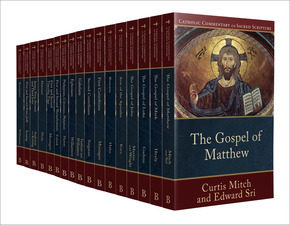 You might have heard of the Catholic Commentary on Sacred Scripture, which finally has produced a complete set of New Testament commentaries. It clocks in at seventeen volumes–all written with a focus on detailed exegesis and an eye to theology and pastoral ministry. The volumes of this series, edited by Scripture scholars Dr. Mary Healy and Dr. Peter Williamson with associate editor Kevin Perotta, have been helpful to me and my students as they have been coming out these past 10-12 years. The first volume was Dr. Healy’s commentary on The Gospel of Mark (2008). The last one to be published was Nathan Eubank’s volume on First and Second Thessalonians (2019).
You might have heard of the Catholic Commentary on Sacred Scripture, which finally has produced a complete set of New Testament commentaries. It clocks in at seventeen volumes–all written with a focus on detailed exegesis and an eye to theology and pastoral ministry. The volumes of this series, edited by Scripture scholars Dr. Mary Healy and Dr. Peter Williamson with associate editor Kevin Perotta, have been helpful to me and my students as they have been coming out these past 10-12 years. The first volume was Dr. Healy’s commentary on The Gospel of Mark (2008). The last one to be published was Nathan Eubank’s volume on First and Second Thessalonians (2019).
